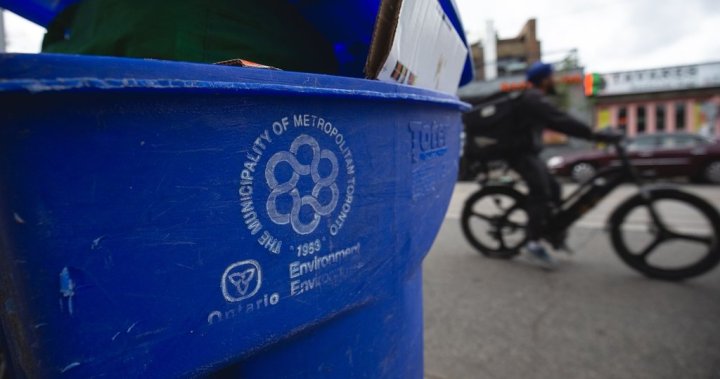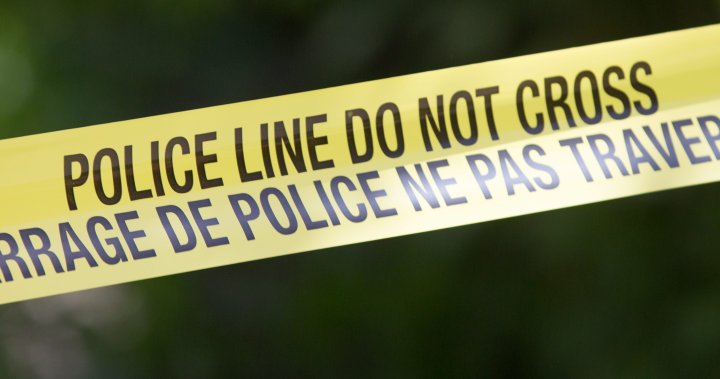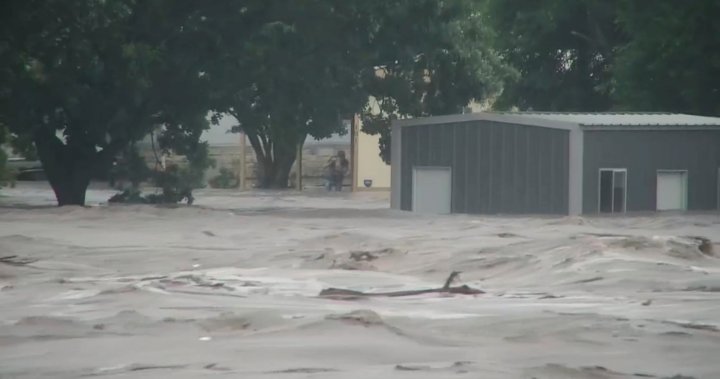Ontario proposes to weaken impending new recycling rules over costs to producers

Ontario Premier Doug Ford’s government is proposing to weaken an impending slate of new recycling rules because producers of the materials said the system is getting too expensive.
The province began transitioning in 2023 toward making producers pay for the recycling of their packaging, paper and single-use items. The companies’ obligations were set to increase next year, but the government is now looking to delay some measures and outright cancel others, such as requirements to extend collection beyond the residential system.
Environmental advocates say the proposed changes let producers off the hook and will mean more materials will end up in landfills or be incinerated. Producers say despite the rising costs, recycling rates don’t actually appear to be improving, so it’s time for a broader rethink.
Environment Minister Todd McCarthy said the proposed changes are about ensuring the sustainability of the blue box system and protecting against unintended consequences such as job losses.
“We want to take what we’ve done and improve upon what already exists, but the costs were a big deal, and so we’re proposing some measures that would bring about cost savings and transparency and improvement to accomplish the goal of recycling that we all want,” he said earlier this month.
The Canadian Retail Council estimates that producer costs have already increased by about 350 per cent in three years and would nearly double again just from this year to next if no changes were made to the impending new rules for 2026.
The government says blue box collection costs could more than double between 2020 and 2030.
“Cost increases of this magnitude were not anticipated when the regulation was passed in 2021 and have jeopardized the stability of the blue box system today,” it says in its proposal to change the rules.
Currently, producers just have to make “best efforts” to hit certain recycling rate percentages, such as 80 per cent of paper and 50 per cent of rigid plastic, and starting next year they are set to be enforceable. Then in 2030 those percentages are set to rise.

Get breaking National news
For news impacting Canada and around the world, sign up for breaking news alerts delivered directly to you when they happen.
But now the government is proposing to delay those 2026 targets to 2031.
As well, Ontario is proposing to allow non-recyclable material that gets incinerated to count for up to 15 per cent of producers’ recycling targets.
Starting next year, producers are also supposed to be responsible for collecting material from more multi-residential buildings, and certain long-term care homes, retirement homes and schools. The government is now proposing to remove that requirement entirely.
The same goes for a rule that would have made beverage producers responsible for containers not just dropped in a residential blue box but also those used outside the home, and a provision for producers to expand collection in public spaces.
The intent behind the initial regulations was to incentivize producers to use less packaging and to use materials that can more easily be recycled, said Karen Wirsig, senior program manager for plastics with Environmental Defence.
These changes would halt any progress on that score, she said.
“Municipalities have been saying for years, ‘Our blue box is getting more and more filled with packaging types we can’t even identify let alone properly sort … because often they’re made with mixed materials that are not easily recycled,’” Wirsig said.
“So because there was that disconnect between the producers who design all this packaging and the municipalities who are collecting it, there was no way to rationalize the system and improve packaging from an environmental and sustainability point of view. These regulations were intended to start doing that, and unfortunately, now all of the incentives are going the opposite direction.”
The recycling of flexible plastics, which includes food wraps, pouches and bags, is a particular bone of contention and the government is proposing to both delay and reduce the target for that category.
In a recycling facility, flexible plastics end up in all sorts of places because they’re so light, getting stuck among paper or falling through the cracks of conveyor belts, said Michael Zabaneh, the Retail Council of Canada’s vice-president of sustainability.
Instead of a recycling target of 25 per cent taking effect next year, a target of five per cent would take effect in 2031 under the government’s proposal for flexible plastics.
That five per cent reflects the estimated current level of flexible plastic diversion, according to the government’s regulatory proposal. It is silent on the current levels for all other materials.
Those current levels are unknown, with the Resource Productivity and Recovery Authority saying it will report on rates once the three-year transition is over. That is a big problem, said Zabaneh.
“We’re all in the blind,” he said. “I think you can’t have a recycling system with accountability, (and not have) transparency and real data.”
The main problem with the government’s current system is that it allows for multiple administrators, said Zabaneh. Producers sign up with producer responsibility organizations, which help them meet their blue box obligations.
There are four such organizations operating in Ontario, which just ends up complicating the system and making it more expensive, Zabaneh said.
“There’s an administrative body to drive collection, but then processing is kind of a competitive thing, and this creates a very fragmented and inefficient system,” he said.
“It limits planning, it prevents collective investment, capital investment, so that’s disincentivized, and you have a lot of added costs from logistics and audits, and that’s why we have escalating costs.”
Retail council members helped found and sit on the board of one producer responsibility organization so they have some idea of recycling rates from that, and based on that limited view the numbers look stagnant, the council says.
Producers welcome the delayed targets, Zabaneh said, but it doesn’t solve the core problem. Having a single producer responsibility organization would reduce costs and allow for greater transparency of recycling rates and financial performance, the retail council says.
Canadian Beverage Association president Krista Scaldwell said their members want the system to be successful because recycling and recovery benefits companies as well as the environment.
“We want the aluminum and plastic back because we can make it into new containers,” she said.
“The members are very committed to sustainability initiatives, and so we need to understand what’s creating the cost so that we can help support some change, so we can see improved recovery without escalating costs.”
Comments on the regulatory registry proposal can be submitted until July 21.


A new poll by Leger has found that Quebec residents are the happiest in Canada.
The web survey of nearly 40,000 Canadians found that Quebecers rated their happiness at an average of 72.4 out of 100, which is well above the national average.
New Brunswick followed Quebec with an average of 70.2, while Manitoba and Prince Edward Island finished at the bottom of the list.
Mississauga, Ont. had the highest happiness rating of the 10 largest cities, while Toronto was lowest.
Montreal finished second in the category.
The survey found that 49 per cent of respondents said their happiness level was unchanged over the past year, while 23 per said they were happier and 28 per cent said they were less happy.
“These results reveal a population that is both resilient and tested, affected by everyday uncertainty and challenges,” Leger’s executive summary read. “Happiness, while holding its ground overall, shows signs of fragility.”

Get breaking National news
For news impacting Canada and around the world, sign up for breaking news alerts delivered directly to you when they happen.
The survey found that people in the 18-to-24 and 24-to-34-year-old categories were more likely to report improved feelings of well-being, even if their overall happiness score remained below the national average.
In contrast, people in the 35-to-44 and 45-to-54 age brackets were more likely to report their happiness had deteriorated.
“There is a sense of well-being emerging among younger age groups,” the summary read. “However, this also highlights the importance of supporting adults in mid-life, who are more vulnerable to the pressures of working life.”
Quebec, New Brunswick and Newfoundland and Labrador were the three provinces with happiness levels above the national average of 68.7. They were followed, in descending order, by Saskatchewan, Nova Scotia, Alberta, British Columbia, Ontario, Manitoba and P.E.I. The territories were not included in the survey.
In the survey of the 10 largest cities, Mississauga and Montreal finished ahead of Hamilton, Calgary, Brampton, Ottawa, Edmonton, Vancouver, Winnipeg and Toronto, in that order.
Women reported slightly higher happiness levels than men, at 69.4 versus 68.0.
Leger says the overall results confirm “a level of happiness that is relatively high but stagnant or even slightly down compared to the pre-pandemic period.”
To get the results, Leger surveyed 39,841 Canadians aged 18 and up between March 31 and April 13.
Online surveys cannot be assigned a margin of error because they do not randomly sample the population.
© 2025 The Canadian Press

Ontario Provincial Police are set to host a town hall in Quadeville, Ont., this evening to answer questions from residents about an attack on an eight-year-old child that was initially linked to an animal.
Police have arrested a 17-year-old boy in the case and he faces charges of attempted murder and sexual assault with a weapon.
Members of the small community 170 kilometres west of Ottawa say they were in shock after hearing about the arrest and hope to get clarity at today’s event in the town’s community centre.
Local resident Christine Hudder says she wants to know how police came up with the animal attack theory and why families were told for days to keep their children indoors.

Get breaking National news
For news impacting Canada and around the world, sign up for breaking news alerts delivered directly to you when they happen.
The victim was found with life-threatening injuries on June 24 after she was reported missing, and remains in hospital.
Police say they are planning to give as much information as possible to locals given that an investigation is still underway.

A Burlington, Ont., mother was unsettled to discover that an old photo of her children had been used in a fraudulent GoFundMe that attempted to elicit donations in connection the recent Texas floods.
Julie Cole told Global News that a friend had contacted her on social media to say that an old photo of her six children was being used in an attempt to collect ill-gotten gains.
“She reached out to me and she was like, ‘Hey, here’s a link to a GoFundMe. Sorry this has happened to you, but obviously a picture of your kids has been used without your consent and it’s being used for a GoFundMe to raise money, to help a family dealing with the Texas floods,’” she said.
Cole explained that the fake GoFundMe, which has since been removed by the company, was looking for donations to support a widowed mother of six kids in connection.
At least 120 people have died while more than 100 others remain unaccounted for as a result of the flooding, including 27 children and councilors from Camp Mystic.
“They were trying to raise $40,000 because of the three daughters had been victims of the Texas floods,” Cole said. “And the way it was presented felt very much like they were part of maybe that girl’s camp.”
Julie Cole told Global News that a friend had contacted her on social media to make that an old photo of her six children was being used in an attempt to collect ill-gotten gains.
Provided
Cole said once the listing was sent to her, she immediately contacted GoFundMe to get the fundraiser taken down.

Get breaking National news
For news impacting Canada and around the world, sign up for breaking news alerts delivered directly to you when they happen.
By Wednesday morning, the company had done so and in a statement to Global News, GoFundMe said that the fundraiser did not receive any donations and the account has been banned from creating any further fundraisers on the platform.
“GoFundMe has the most robust donor protection processes of any platform of our kind. We have round the clock trust and safety support, humans and technology making sure funds will get to where they are intended,” the statement offered.
After contacting the company, Cole said she shared the incident on her social media pages to raise awareness.
“So I did put it on my Facebook and I put it in my LinkedIn as like a heads-up learning experience kind of thing and there was a lot of outrage,” she said.
Cole also noted that while she is disappointed by the incident, she is well aware that her troubles are miniscule in comparison to those affected by the flooding.
“I do feel a little bit in myself that what I’m feeling is in no way comparable to what the actual families are feeling who have gone through the tragedies of the flooding,” she said.
The photo came from an old blog post she had written 16 years ago. Cole can date the picture as the baby in the photo is now getting ready to go for his driver’s test.
“I’m one of those, like, OG mommy bloggers from 20 years ago. So my kids have been on the internet. They have been sort of in the public eye,” she explained.
“And I know the risk is out there. And I think parents need to remember that, that their kids’ photos can be just screenshotted and used without consent. So there’s one lesson.
“I felt a little, well, very unsettled about it, particularly because of what it was being used for.”
In addition to being a parenting blogger, she also helped found Mabel’s Labels, which offers washable labels for kids clothing and other school items, in an effort to keep them out of the lost and found.
Julie Cole and her six kids in 2025.
Provided
Being a spokesperson for the company while raising six kids keeps her in the parenting sphere and she offered some other advice to parents about the images and social media.
“I think parents just have to be mindful and aware that once it’s out there, you know you’d like to think you’ll get consent or you’ll give consent if somebody asks or they want to use it, but people will just take it and they can just take,” she said.
“You have to be especially careful now with AI, because these photos can be altered.”
She also warned parents to check with their kids as they get older to see if they are OK with pics being posted and that people should be mindful of where they are sharing their donations.
“Another lesson out of this is people need to really be cautious and know where they’re putting their fundraising dollars,” Cole said.
© 2025 Global News, a division of Corus Entertainment Inc.
-

 Uncategorized1 month ago
Uncategorized1 month agoShop Proud, Eat Proud, Be Proud — Ottawa Canada Day Market This June 28th
-

 4 weeks ago
4 weeks agoCanada’s world junior trial saw juries tossed, intense testimony. Here’s a recap
-

 4 weeks ago
4 weeks agoMeasles circulating in northeastern B.C. community, health officials warn
-

 4 weeks ago
4 weeks agoAnishinabek Nation chief says he briefed Ontario police on protests against Bill 5
-

 4 weeks ago
4 weeks agoRing of Fire road to bring prosperity to First Nation, problems for caribou: report
-

 4 weeks ago
4 weeks agoJagmeet Singh apologizes for attending Kendrick Lamar concert after Drake calls him out
-

 4 weeks ago
4 weeks agoFormer major leaguer, Jays doctor Ron Taylor dies
-

 4 weeks ago
4 weeks agoDreaming of a lakeside cottage but can’t afford it? Co-ownership could open that door








